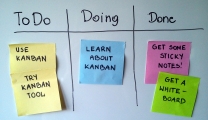Balancing Demand against Throughput is the Cornerstone
To achieve a stable workflow, you need to introduce a pull system, balance demand against throughput, and limit the amount of work in progress. These are practices of the Kanban Method.
Balancing demand against throughput implies that teams set a rate at which they accept new work that corresponds with the rate at which they deliver work. This means that they set a fixed limit to the amount of work in progress. As work is delivered, they pull new work.
The effect of this approach is profound. According to Little’s Law, balancing the arrival and departure rates leads to more predictable and stable processes. Furthermore, based on the Theory of Constraints, the throughput of a workflow is limited by the throughput of the slowest step in that workflow. This bottleneck reveals itself right away. By balancing demand against throughput and limiting WIP, only the team members currently in the bottleneck remain fully loaded, while the rest of the team will find they have idle capacity.

How to Use the Cumulative Flow Diagram to Measure Arrival and Departure Rates
Why Idle Time Is Not Your Enemy
Allowing idle time in your workflow offers many advantages. Aside from alleviating much of the stress, your team will be able to deliver work with precision and quality. The team’s self-confidence will also increase, and they’ll be proud of their results. Idle team members will use that time for improving their skills, their tools, taking training sessions or improving interaction within the team. As time passes, and one small improvement leads to another, your team will become more efficient and self-managed.

Very often, management intuitively tries to eliminate idle time. After limiting work in progress and balancing demand against throughput, the tendency is to adjust team engagement so that everyone is fully utilized. Although it may look efficient and feel satisfying, such attempts could disrupt the growth of your team and the consistency of your workflow. Worse still, it can increase the chances of burnout. Optimizing individual performance very often contradicts the optimization of the overall workflow efficiency and is therefore undesirable.
You need idle time for your team to make small long-term improvements and achieve an efficient workflow. The most effective change management process puts people first. Teams are motivated and highly dedicated, building their relationships on trust and respect. Companies that empower self-improvement initiatives for their teams are much more successful than those who try to utilize every minute. That’s exactly the sort of mindset project leaders need to inspire their teams, lead by example, and build a culture of success in which workflow efficiency is constantly improving.












Replies to This Discussion